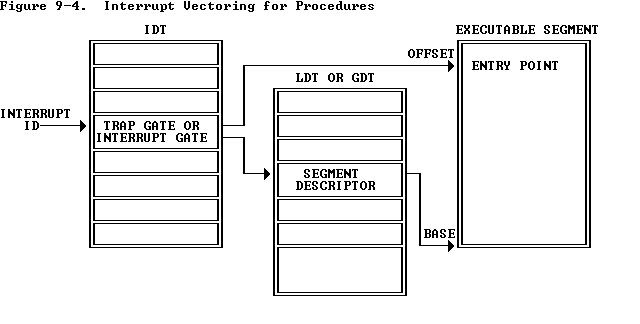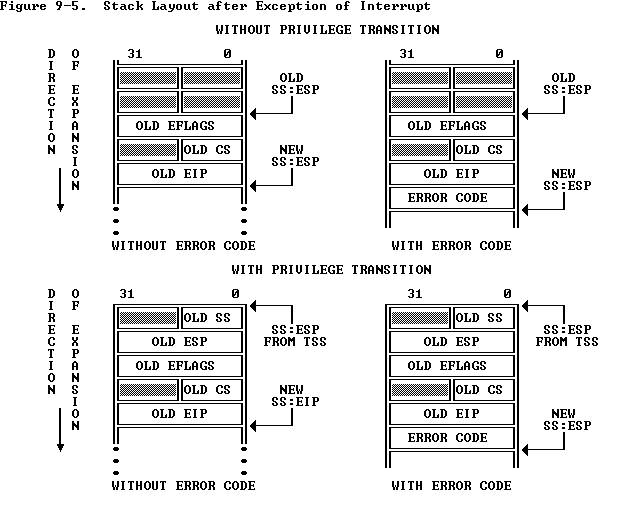up:
Chapter 9 -- Exceptions and Interrupts
prev: 9.5 IDT Descriptors
next: 9.7 Error Code
9.6 Interrupt Tasks and Interrupt Procedures
Just as a CALL instruction can call either a procedure or a task, so an
interrupt or exception can "call" an interrupt handler that is either a
procedure or a task. When responding to an interrupt or exception, the
processor uses the interrupt or exception identifier to index a descriptor
in the IDT. If the processor indexes to an interrupt gate or trap gate, it
invokes the handler in a manner similar to a CALL to a call gate. If the
processor finds a task gate, it causes a task switch in a manner similar to
a CALL to a task gate.
9.6.1 Interrupt Procedures
An interrupt gate or trap gate points indirectly to a procedure which will
execute in the context of the currently executing task as illustrated by
Figure 9-4
. The selector of the gate points to an executable-segment
descriptor in either the GDT or the current LDT. The offset field of the
gate points to the beginning of the interrupt or exception handling
procedure.
The 80386 invokes an interrupt or exception handling procedure in much the
same manner as it
CALLs a procedure; the differences are explained in the
following sections.

9.6.1.1 Stack of Interrupt Procedure
Just as with a control transfer due to a CALL instruction, a control
transfer to an interrupt or exception handling procedure uses the stack to
store the information needed for returning to the original procedure. As
Figure 9-5
shows, an interrupt pushes the EFLAGS register onto the stack
before the pointer to the interrupted instruction.
Certain types of exceptions also cause an error code to be pushed on the
stack. An exception handler can use the error code to help diagnose the
exception.
9.6.1.2 Returning from an Interrupt Procedure
An interrupt procedure also differs from a normal procedure in the method
of leaving the procedure. The
IRET instruction is used to exit from an
interrupt procedure. IRET is similar to
RET except that
IRET increments ESP
by an extra four bytes (because of the flags on the stack) and moves the
saved flags into the EFLAGS register. The IOPL field of EFLAGS is changed
only if the CPL is zero. The IF flag is changed only if CPL <= IOPL.

9.6.1.3 Flags Usage by Interrupt Procedure
Interrupts that vector through either interrupt gates or trap gates cause
TF (the trap flag) to be reset after the current value of TF is saved on the
stack as part of EFLAGS. By this action the processor prevents debugging
activity that uses single-stepping from affecting interrupt response. A
subsequent IRET instruction restores TF to the value in the EFLAGS image on
the stack.
The difference between an interrupt gate and a trap gate is in the effect
on IF (the interrupt-enable flag). An interrupt that vectors through an
interrupt gate resets IF, thereby preventing other interrupts from
interfering with the current interrupt handler. A subsequent
IRET
instruction restores IF to the value in the EFLAGS image on the stack. An
interrupt through a trap gate does not change IF.
9.6.1.4 Protection in Interrupt Procedures
The privilege rule that governs interrupt procedures is similar to that for
procedure calls: the CPU does not permit an interrupt to transfer control to
a procedure in a segment of lesser privilege (numerically greater privilege
level) than the current privilege level. An attempt to violate this rule
results in a general protection exception.
Because occurrence of interrupts is not generally predictable, this
privilege rule effectively imposes restrictions on the privilege levels at
which interrupt and exception handling procedures can execute. Either of the
following strategies can be employed to ensure that the privilege rule is
never violated.
- Place the handler in a conforming segment. This strategy suits the
handlers for certain exceptions (divide error, for example). Such a
handler must use only the data available to it from the stack. If it
needed data from a data segment, the data segment would have to have
privilege level three, thereby making it unprotected.
- Place the handler procedure in a privilege level zero segment.
9.6.2 Interrupt Tasks
A task gate in the IDT points indirectly to a task, as
Figure 9-6
illustrates. The selector of the gate points to a TSS descriptor in the GDT.
When an interrupt or exception vectors to a task gate in the IDT, a task
switch results. Handling an interrupt with a separate task offers two
advantages:
- The entire context is saved automatically.
- The interrupt handler can be isolated from other tasks by giving it a
separate address space, either via its LDT or via its page directory.
The actions that the processor takes to perform a task switch are discussed
in
Chapter 7.
The interrupt task returns to the interrupted task by
executing an IRET instruction.
If the task switch is caused by an exception that has an error code, the
processor automatically pushes the error code onto the stack that
corresponds to the privilege level of the first instruction to be executed
in the interrupt task.
When interrupt tasks are used in an operating system for the 80386, there
are actually two schedulers: the software scheduler (part of the operating
system) and the hardware scheduler (part of the processor's interrupt
mechanism). The design of the software scheduler should account for the fact
that the hardware scheduler may dispatch an interrupt task whenever
interrupts are enabled.

up:
Chapter 9 -- Exceptions and Interrupts
prev: 9.5 IDT Descriptors
next: 9.7 Error Code



